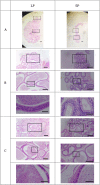Blood-Testis Barrier and Sperm Delayed in the Cauda Epididymis of the Reproductively Regressed Syrian Hamsters
- PMID: 33977170
- PMCID: PMC8087257
- DOI: 10.12717/DR.2021.25.1.1
Blood-Testis Barrier and Sperm Delayed in the Cauda Epididymis of the Reproductively Regressed Syrian Hamsters
Abstract
The Syrian (golden) hamsters are seasonal breeders whose reproductive functions are active in summer and inactive in winter. In experimental facility mimicking winter climate, short photoperiod (SP) induces gonadal regression. The blood-testis barrier (BTB) of the sexually involuted animals have been reported to be permeable, allowing developing germ cells to be engulfed or sloughed off the epithelium of the seminiferous tubules. The expressions of genes related to the tight junction composing of BTB were investigated in the reproductive active and inactive testes. Claudin-11, occludin, and junctional adhesion molecule (JAM) were definitely expressed in the active testes but not discernably detected in the inactive testes. And spermatozoa (sperm) were observed in the whole lengths of epididymides in the active testes. They were witnessed in only cauda region of the epididymides but not in caput and corpus regions in animals with the inactive testes. The results imply that the disorganization of BTB is associated with the testicular regression. The developing germ cells are swallowed into the Sertoli cells or travel into the lumen, as supported by the presence of the sperm delayed in the last region of the epididymis. These outcomes suggest that both apoptosis and desquamation are the processes that eliminate the germ cells during the regressing stage in the Syrian hamsters.
Keywords: Blood-testis barrier; Male Syrian hamster; Photoperiod; Reproductive activity.
© Copyright 2021 The Korean Society of Developmental Biology.
Conflict of interest statement
The authors declare no potential conflict of interest.
Figures






Similar articles
-
Cell adhesion function was altered during the seasonal regression of the seminiferous epithelium in the mink species Neovison vison.J Anim Sci. 2023 Jan 3;101:skad190. doi: 10.1093/jas/skad190. J Anim Sci. 2023. PMID: 37282598 Free PMC article.
-
Influence of age and photoperiod on steroidogenic function of the testis in the golden hamster.Int J Androl. 1999 Aug;22(4):243-52. doi: 10.1046/j.1365-2605.1999.00175.x. Int J Androl. 1999. PMID: 10442297
-
The Expressional Pattern of Epididymal Protease Inhibitor (EPPIN) in the Male Syrian Hamsters.Dev Reprod. 2018 Sep;22(3):253-262. doi: 10.12717/DR.2018.22.3.253. Epub 2018 Sep 30. Dev Reprod. 2018. PMID: 30324162 Free PMC article.
-
Expressions of Semenogelin Gene in Male Syrian Hamsters according to Photoperiod.Dev Reprod. 2019 Dec;23(4):355-365. doi: 10.12717/DR.2019.23.4.355. Epub 2019 Dec 31. Dev Reprod. 2019. PMID: 31993541 Free PMC article.
-
Tissue microcircumstances for leukocytic infiltration into the testis and epididymis in mice.J Reprod Immunol. 2005 Oct;67(1-2):57-67. doi: 10.1016/j.jri.2005.06.007. Epub 2005 Aug 18. J Reprod Immunol. 2005. PMID: 16111766 Review.
Cited by
-
Androgen-induced ferroptosis regulates seasonal testicular regression: insights into adaptive mechanisms of seasonal breeding.BMC Genomics. 2025 Jul 8;26(1):644. doi: 10.1186/s12864-025-11770-z. BMC Genomics. 2025. PMID: 40629305 Free PMC article.
-
Cell adhesion function was altered during the seasonal regression of the seminiferous epithelium in the mink species Neovison vison.J Anim Sci. 2023 Jan 3;101:skad190. doi: 10.1093/jas/skad190. J Anim Sci. 2023. PMID: 37282598 Free PMC article.
-
Expressions of Gonadotropin Subunit Genes in the Reproductively Inactive Golden Hamsters.Dev Reprod. 2022 Jun;26(2):37-47. doi: 10.12717/DR.2022.26.2.37. Epub 2022 Jun 30. Dev Reprod. 2022. PMID: 35950168 Free PMC article.
-
Immune Rejection Mediated by prf1 and gzmb Affects the Colonization of Fat Greenling (Hexagrammos otakii) Spermatogonia in Heterotransplantation.Int J Mol Sci. 2024 May 9;25(10):5157. doi: 10.3390/ijms25105157. Int J Mol Sci. 2024. PMID: 38791196 Free PMC article.
References
-
- Andersen Berg K, Wiger R, Dahl E, Torp T, Farstad W, Krogenaes A, McNeilly AS, Paulenz H, Ropstad E. Seasonal changes in spermatogenic activity and in plasma levels of FSH, LH and testosterone, and the effect of immunization against inhibin in the male silver fox (Vulpes vulpes) Int J Androl. 2001;24:284–294. doi: 10.1046/j.1365-2605.2001.00300.x. - DOI - PubMed
-
- Choi D, Lee SH. Neuroendocrine system in seasonal breeder: Focusing on the reproductive activity of male golden hamster. Dev Reprod. 2012;16:1–8.
-
- Dadhich RK, Barrionuevo FJ, Real FM, Lupiañez DG, Ortega E, Burgos M, Jiménez R. Identification of live germ-cell desquamation as a major mechanism of seasonal testis regression in mammals: A study in the Iberian mole (Talpa occidentalis) Biol Reprod. 2013;88:101. doi: 10.1095/biolreprod.112.106708. - DOI - PubMed
LinkOut - more resources
Full Text Sources
Other Literature Sources

